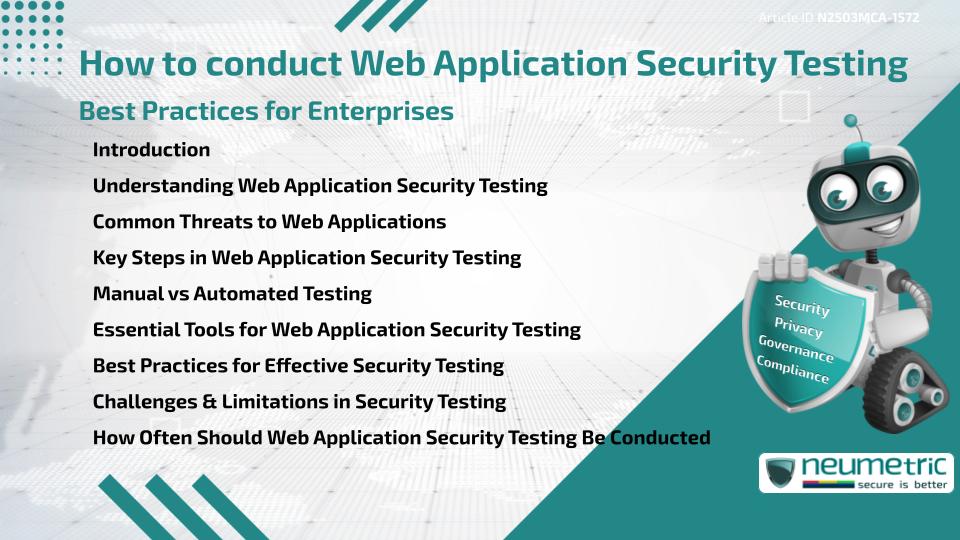Table of Contents
ToggleIntroduction
Web applications are a prime target for cybercriminals. Security testing ensures Vulnerabilities are identified & mitigated before attackers exploit them. This guide explains How to conduct Web Application security testing effectively, covering essential steps, tools & Best Practices.
Understanding Web Application Security Testing
Web Application security testing involves evaluating applications for Vulnerabilities that could be exploited by attackers. The goal is to strengthen security controls & protect Sensitive Data.
Common Threats to Web Applications
- SQL Injection: Attackers manipulate database queries.
- Cross-Site Scripting (XSS): Malicious scripts execute in User browsers.
- Cross-Site Request Forgery (CSRF): Users perform unintended actions.
- Security Misconfigurations: Insecure settings expose applications.
- Broken Authentication: Weak credential management leads to breaches.
Key Steps in Web Application Security Testing
- Gather Information: Identify technologies, frameworks & endpoints.
- Identify Threats: Analyze attack vectors specific to the application.
- Perform Vulnerability Scanning: Use automated tools to detect weaknesses.
- Conduct Penetration Testing: Simulate real-world attacks to evaluate security.
- Review & Remediate: Address identified Vulnerabilities & retest.
Manual vs Automated Testing
- Manual Testing: Human-driven testing finds complex logic flaws.
- Automated Testing: Uses tools to scan for common Vulnerabilities quickly.
- Hybrid Approach: Combines manual expertise with automated efficiency.
Essential Tools for Web Application Security Testing
- Burp Suite: Comprehensive security testing platform.
- OWASP ZAP: Open-source Vulnerability scanner.
- Nikto: Web server scanner.
- Nmap: Network discovery & security auditing.
- Metasploit: Penetration Testing Framework.
Best Practices for Effective Security Testing
- Follow OWASP Guidelines: Align testing with OWASP Top 10 security Risks.
- Regularly Update Dependencies: Reduce Risks from outdated software.
- Use Secure Coding Practices: Prevent Vulnerabilities at the development stage.
- Implement Strong Authentication: Enforce multi-factor authentication.
- Conduct Security Testing Frequently: Test applications at each development phase.
Challenges & Limitations in Security Testing
- False Positives: Automated tools may flag non-issues.
- Evolving Threat Landscape: New attack methods require ongoing adaptation.
- Time & Resource Constraints: Comprehensive testing demands skilled professionals.
- Limited Access to Source Code: Black-box testing restricts Vulnerability discovery.
How Often Should Web Application Security Testing Be Conducted?
Security testing should be conducted:
- During Development: Identify Vulnerabilities early.
- Before Deployment: Ensure the application is secure before release.
- Regularly in Production: Monitor & address new security Risks.
- After Major Updates: Changes can introduce Vulnerabilities.
Conclusion
Web Application security testing is essential for protecting Sensitive Data & maintaining User trust. By following a structured approach, leveraging industry-standard tools & implementing Best Practices, businesses can significantly reduce security Risks. Regular testing, combined with a proactive security strategy, helps safeguard applications against evolving Cyber Threats.
Takeaways
- Web Application security testing is crucial for protecting data.
- A combination of manual & automated testing improves effectiveness.
- Regular testing minimizes security Risks & ensures Compliance.
- Using industry-standard tools enhances security testing processes.
FAQ
What is the purpose of Web Application security testing?
Web Application security testing identifies Vulnerabilities & ensures applications are secure from Cyber Threats.
How often should Web Application security testing be conducted?
Testing should be conducted during development, before deployment, after major updates & regularly in production.
What are the most common Web Application Vulnerabilities?
Common Vulnerabilities include SQL injection, XSS, CSRF, broken authentication & security misconfigurations.
What tools are used for Web Application security testing?
Popular tools include Burp Suite, OWASP ZAP, Nikto, Nmap & Metasploit.
What is the difference between manual & automated security testing?
Manual testing finds complex logic flaws, while automated testing quickly detects common Vulnerabilities.
How does OWASP help with Web Application security testing?
OWASP provides guidelines, tools & the Top 10 security Risks to improve Web Application security.
Can Web Application security testing prevent all cyber attacks?
No, but regular testing reduces the Risk & improves security by identifying & fixing Vulnerabilities.
What are the limitations of automated security testing?
Automated testing may generate false positives & miss business logic Vulnerabilities.
Why is Penetration Testing important for web applications?
Penetration Testing simulates real-world attacks to assess the application’s security posture.
Need help?
Neumetric provides organisations the necessary help to achieve their Cybersecurity, Compliance, Governance, Privacy, Certifications & Pentesting goals.
Organisations & Businesses, specifically those which provide SaaS & AI Solutions, usually need a Cybersecurity Partner for meeting & maintaining the ongoing Security & Privacy needs & requirements of their Clients & Customers.
SOC 2, ISO 27001, ISO 42001, NIST, HIPAA, HECVAT, EU GDPR are some of the Frameworks that are served by Fusion – a centralised, automated, AI-enabled SaaS Solution created & managed by Neumetric.
Reach out to us!


